What is an EV fleet? Tips for electric vehicle fleet management
Learn about benefits, challenges and best practices for EV fleet management.

Key Insights
- An EV fleet comprises electric vehicles owned or leased by a business.
- Fleet electrification offers potential savings of $33 million and 194,000 tons of CO₂ emissions over four years.
- EVs reduce emissions, lower costs and simplify maintenance for streamlined fleet management.
Monitoring the performance of the vehicles in your fleet is essential for maximizing efficiency and profitability. And with 69% of fleet managers using sustainability data to reduce operating costs, incorporating green energy is crucial. But what is an EV fleet?
An EV fleet is composed of electric vehicles owned or leased by a business, including battery electric (BEVs) and plug-in hybrid electric (PHEVs). Let’s break down the benefits of electrification and what to consider before switching to electric vehicles.
What is EV fleet management?
Electric vehicle fleet management involves overseeing EV operations, including the acquisition of electric vehicles, the management of charging infrastructure and the implementation of maintenance and repair needs. This includes optimizing charging schedules, tracking vehicle performance and ensuring driver training to maximize the benefits of electric vehicle technology.
The duties of an EV fleet manager include:
- Data analysis: Utilizing data to optimize charging times, vehicle utilization and energy consumption.
- Driver education: Providing training on EV technology, charging procedures and range management.
- Financial management: Budgeting for vehicle acquisition, charging infrastructure and maintenance costs.
- Sustainability goals: Aligning EV fleet management with broader corporate sustainability objectives.
Benefits of fleet electrification
Switching to electric vehicles benefits everyone, including fleets. Not only are there rebates and tax incentives for electrifying fleets, but switching to EVs also provides gas and maintenance savings to lower costs and simplify fleet management. Whether EVs are right for your fleet will depend on the benefits you’re looking for and how committed you are to building a sustainable fleet.

Lowers costs
Total cost of ownership (TCO) encompasses both upfront costs and ongoing expenses throughout a vehicle's lifespan. While electric vehicles may have higher initial price tags, they often offer long-term savings due to lower fuel and maintenance costs.
In fact, fleet electrification could save $33 million and 194,000 tons of CO₂ emissions over four years. Additionally, reduced energy consumption and fewer moving parts contribute to lower operational expenses.
Reduces emissions
With new environmental goals and forms of clean energy on the horizon, reducing vehicle emissions is a top priority. And while gasoline-powered vehicles emit over 12,500 pounds of CO₂ each year, all-electric vehicles produce roughly 80% fewer CO₂ emissions annually, accounting for vehicle manufacturing and electricity production and transmission. Transitioning to an EV fleet can significantly lower your carbon footprint and meet compliant needs while saving on fuel and maintenance costs.
See also: Simplify EV fleet compliance
Simplifies maintenance
Speaking of maintenance, because EVs require less fluid and oil upkeep, electrification can actually help streamline your fleet maintenance initiatives. Electric vehicles eliminate the need for oil changes, transmission fluid, fuel filters, coolant and spark plug replacements due to their electric power source.
Future-proofs your fleet
In an effort to combat climate change, numerous countries are working to phase out all combustion engine vehicles and require 100% of new vehicle sales to be zero-emission by 2040 or earlier. With EV fleet regulations on the horizon, early adopters of electric heavy-duty trucks can reap the benefits of government incentives and get ahead of the curve.
Offers performance incentives
Reduced noise may come to mind when you think of electric cars, but EVs also offer many features to maximize efficiency. Many models include eco settings that optimize performance for energy savings.
Regenerative braking, which converts kinetic energy back into battery power, is a key feature. Drivers can often adjust the intensity of regenerative braking to suit their driving style.
What to consider before going electric
Transitioning to EVs is not going to happen overnight and fleet managers need to be able to manage all of the vehicles in their fleet. So, before you put an EV adoption strategy in place, it’s important to consider key aspects like charging infrastructure and driver training.
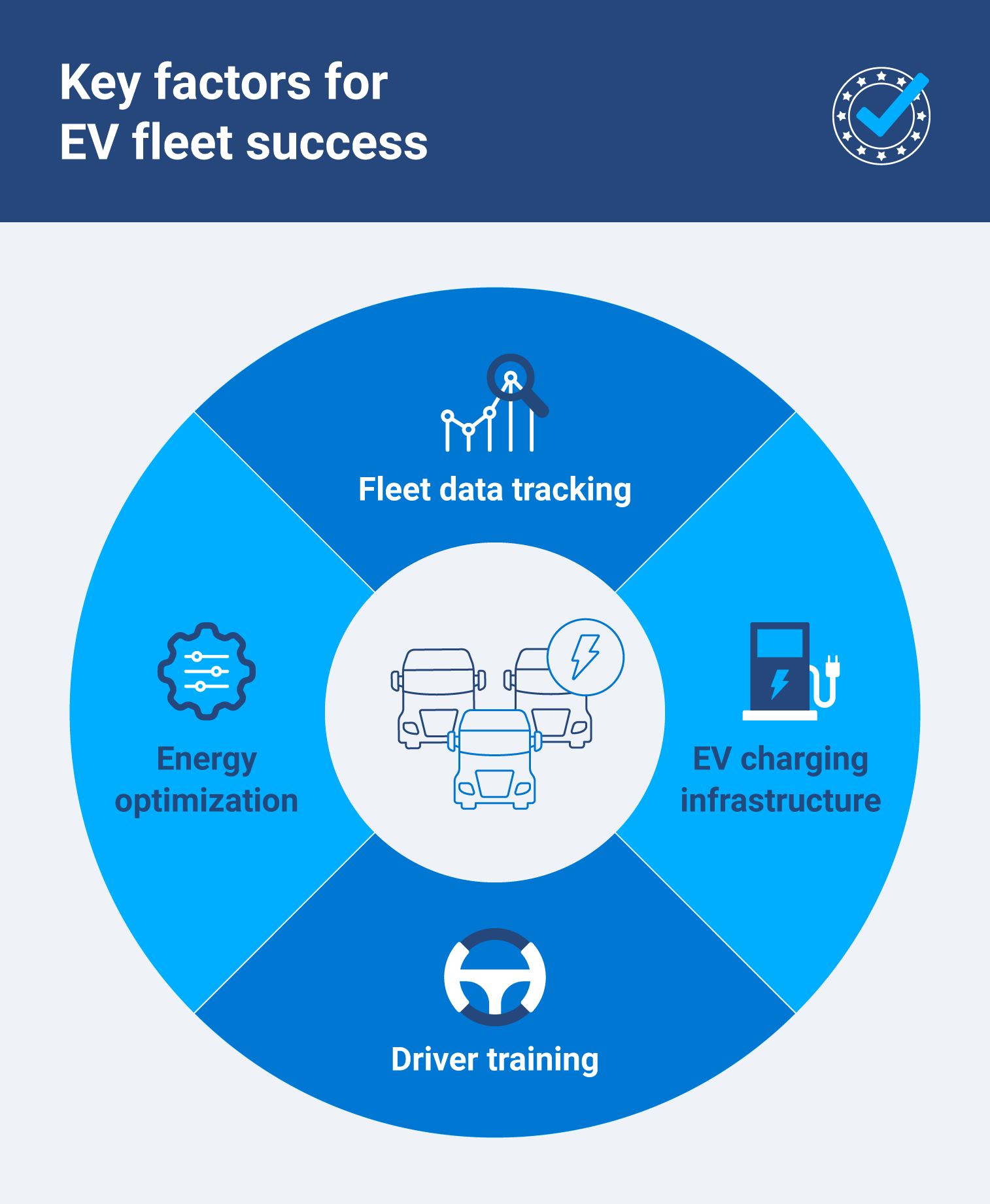
Fleet data tracking
The main difference you’ll experience with EVs in your fleet is how they “fuel up.” And this transition introduces new data-driven opportunities. By closely monitoring energy consumption, measured in kilowatt-hours (kWh), fleet managers can gain valuable insights into vehicle performance, charging efficiency and overall operational costs.
But energy consumption isn’t the only metric you can track. Charging schedules, vehicle maintenance and real-time location tracking are all key for maximizing vehicle uptime and optimizing EV fleet management.
EV charging infrastructure
Since EV state of charge (SOC) is an essential metric, you’ll also need to decide whether your fleet will use public or private charging ports (or both) and the cost of EV fleet charging infrastructure. For example, if you permit drivers to charge EVs at home , you can use SOC data to reimburse drivers for the electricity cost.
An EV’s SOC is, in some ways, very similar to a traditional fuel indicator: it shows how “full” the battery is. Since charging takes longer to “fill up the tank” and there aren’t chargers on every street corner, it is more important to keep an eye on this metric.
Energy optimization
Tracking energy data is crucial to maintain and potentially cut costs. Data-rich logs should include information such as:
- When and where each individual EV is charging
- The full charging duration
- Starting and ending SOC
This data will allow you to create and optimize a charging schedule. Rather than simply charging all of the vehicles at the end of the day, it may be possible to stagger them in between duty cycles or “top up” at a strategically placed charger mid-cycle to optimize energy consumption.
Electrify your fleet with confidence
Driver training
Driver engagement is crucial for a successful EV fleet transition. Comprehensive training programs should equip drivers with the knowledge to maximize vehicle range, optimize charging habits and understand the unique characteristics of electric vehicles. Training materials should also include safety and maintenance protocols for both drivers and repair technicians.
Tips to optimize your EV fleet with notifications
How can you get your drivers to remember to plug in their EVs when they return to the lot? Or, what about making sure a driver isn’t leaving the depot with insufficient charge? While these may seem like tough questions, they have simple answers: by utilizing fleet tracking notifications with Geotab’s EV fleet solutions and sustainability partnerships.
Set low-charge alerts
This rule helps you receive a notification to know when an EV has dropped below a specified charge percentage level and is at risk of not completing its daily routes. Never worry about a vehicle not having sufficient charge to complete its route with this custom trigger notification.
Fleet managers can prevent EVs from getting stranded with insufficient charge, or forcing an unplanned charging stop during the day, which would create a large productivity and time loss for the driver.

Assign charging zones
Assigning charging zones triggers an alert when a driver is near a charger and when they are driving away from one. This will provide drivers with a reminder that their EV needs to be charged. It can also help fleet managers identify which EVs need to be prioritized and charged first.
You can also establish no-charge time rules to eliminate charging during peak electricity rate times and receive notifications when a vehicle is charging during that time.

Trigger done-charging notifications
This rule will trigger when an EV is charged to the configured value. This helps fleet managers prioritize charging schedules by knowing when an EV is done and fully charged so the next one can plug in.
Tip: The battery charge takes into account the engine measurement generic state of charge. If your configured value is lower than 100%, change the default to whatever figure you would like to get the notification at.

Drive efficiency with EV fleet management software
If you’ve been wanting to reduce fleet CO₂ emissions but aren’t sure how to get started, understanding what an EV fleet is and the top barriers to electrification is key. MyGeotab allows fleet managers to proactively manage their EVs to prevent issues and measure productivity.
As a fleet manager, you will be alerted when something goes wrong so problems can be solved quickly and more efficiently. Achieve your sustainability goals with streamlined fleet management.

Subscribe to get industry tips and insights
Frequently Asked Questions
EV fleet refers to a fleet of electric vehicles. EV fleets consist of electric vehicles owned or leased by a business, including battery electric (BEVs) and plug-in hybrid electric (PHEVs).
EV fleet management oversees electric vehicle operations, from purchasing and maintaining vehicles to managing charging infrastructure. This includes optimizing charging, tracking vehicle performance and training drivers to maximize EV benefits.
EV fleet challenges include insufficient charging infrastructure, higher upfront costs compared to traditional vehicles and range anxiety. Data tracking can help mitigate these issues by optimizing energy use and lowering costs.
The Geotab Team write about company news.
Table of Contents
Subscribe to get industry tips and insights
Related posts
.jpg)
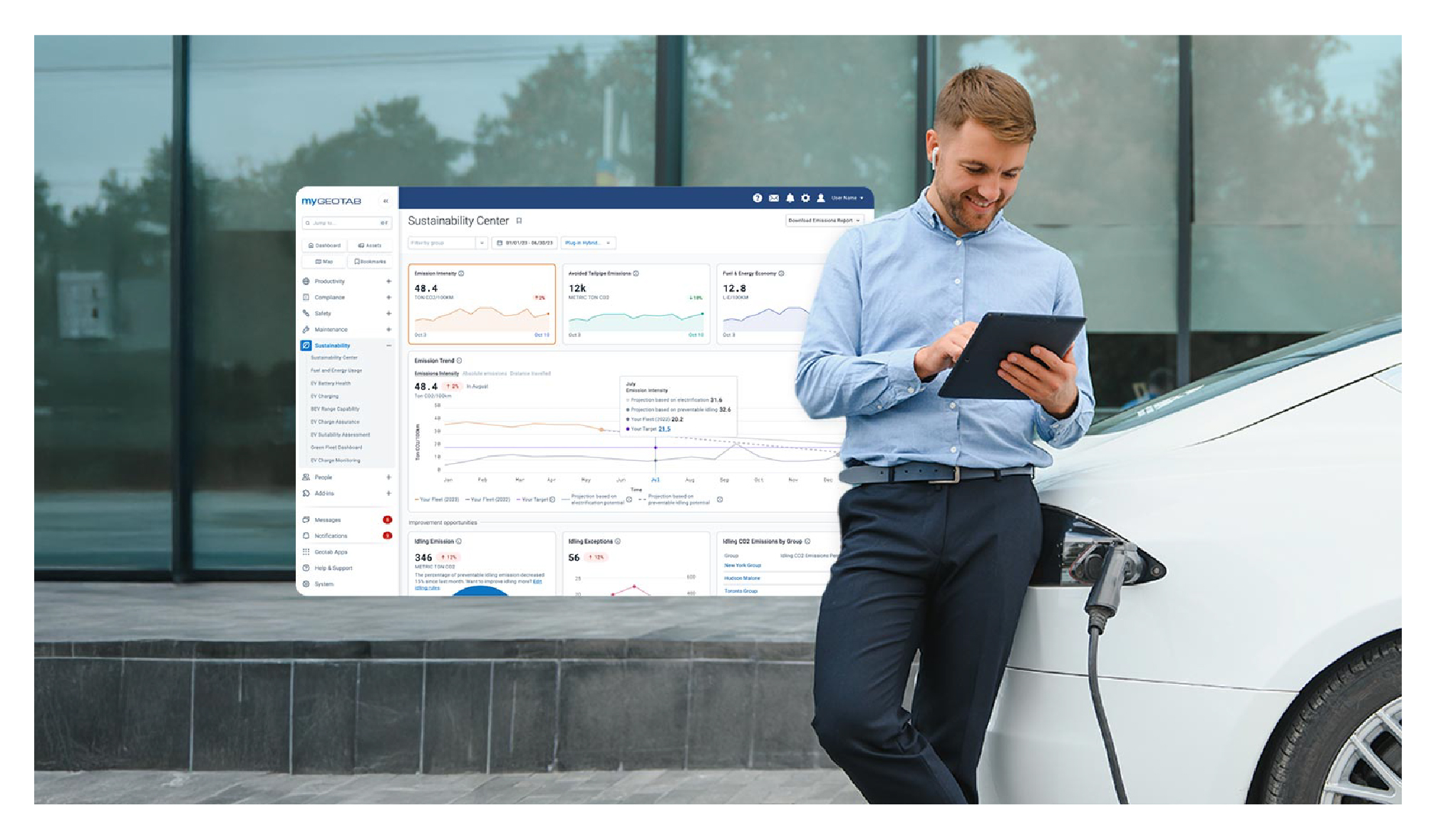
Geotab’s new fleet Sustainability Center simplifies fuel and emissions reduction
March 3, 2025
3 minute read
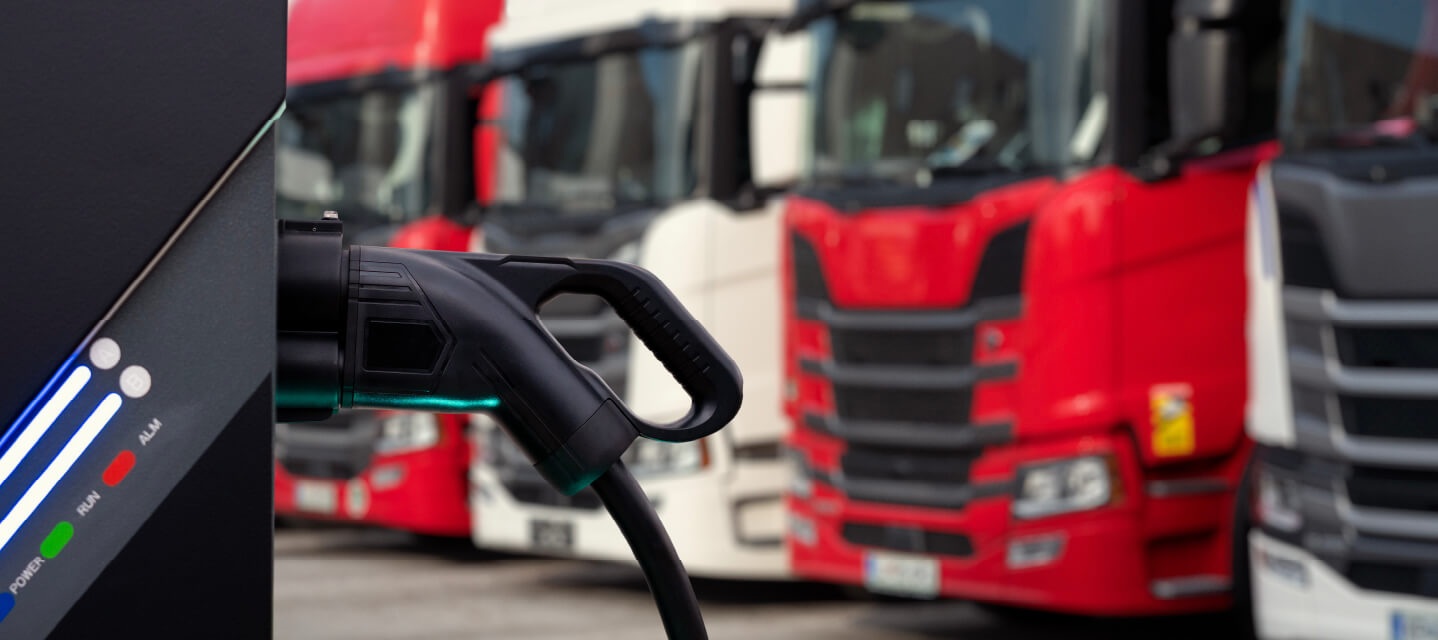
How long do electric car batteries last? What analyzing 10,000 EVs tells us…
January 20, 2025
9 minute read
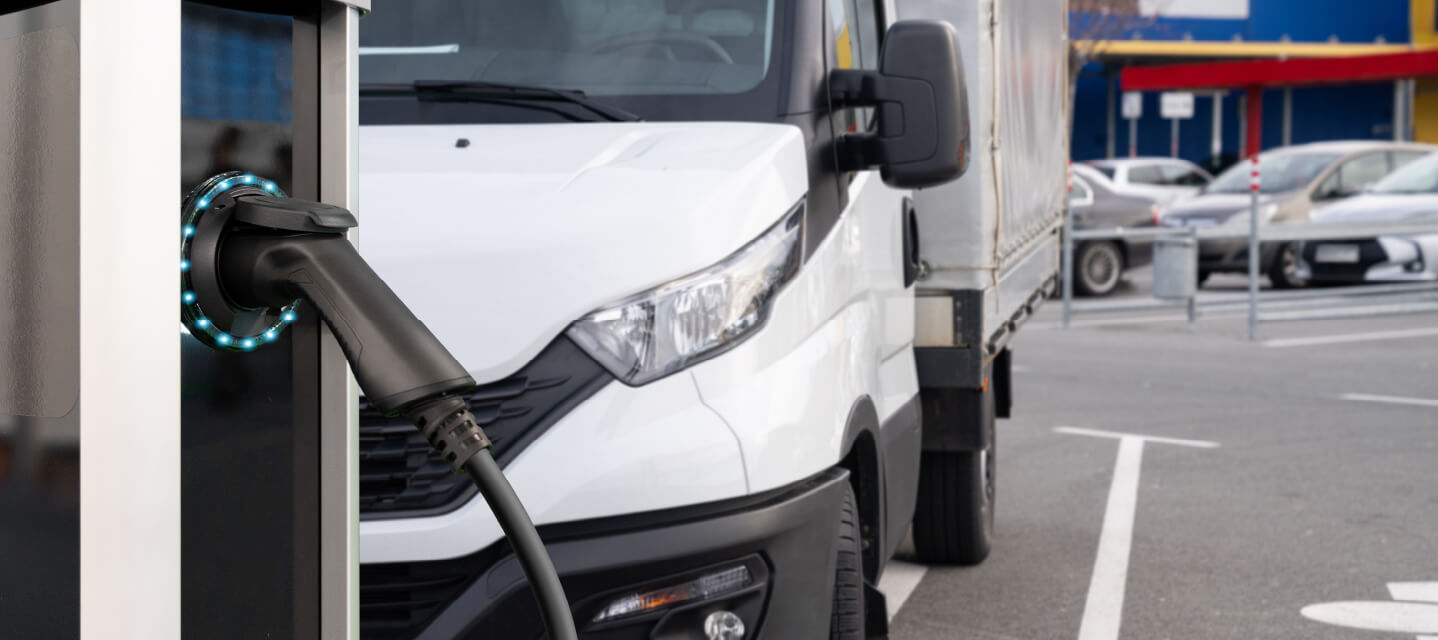
What is fleet electrification? (+ How to build a sustainable strategy)
January 13, 2025
4 minute read

How cold weather affects EV performance: 6 tips for EV winter driving
November 11, 2024
1 minute read
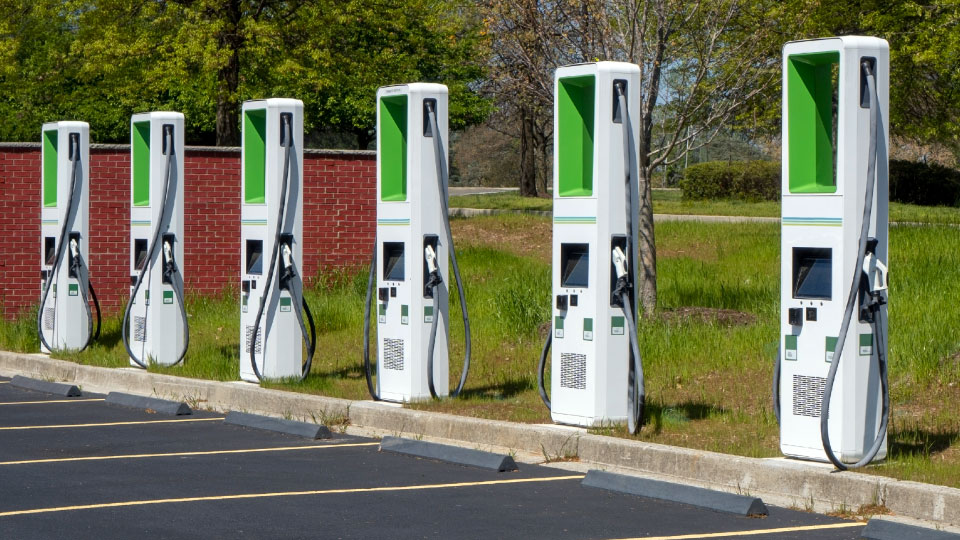
Geotab and the Electric Vehicle in Spain: Innovation at the Service of Sustainability
September 9, 2024
1 minute read